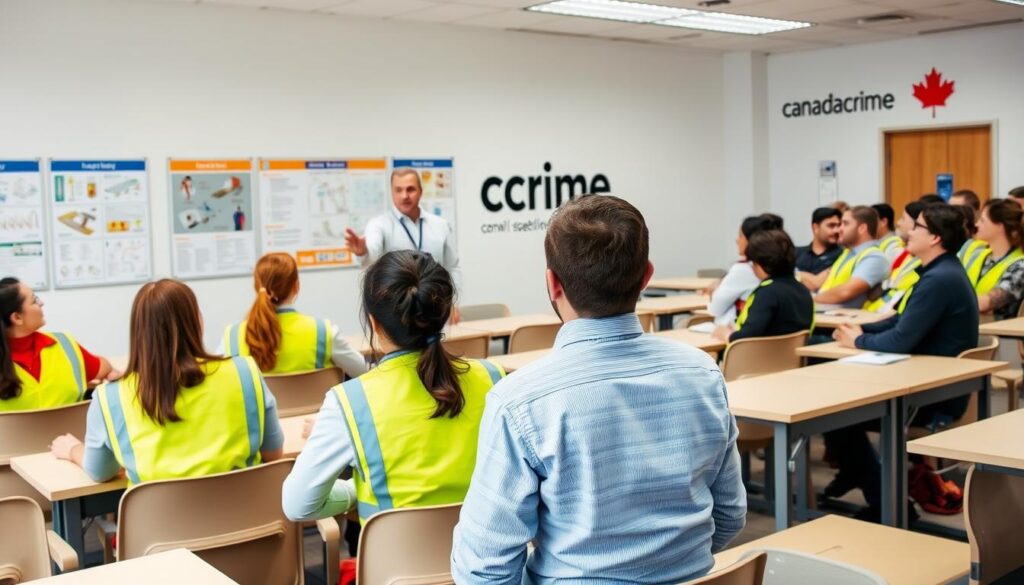Did you know nearly 45% of workplace accidents in Canada are due to criminal negligence? This is a wake-up call for taking steps to prevent it in work settings. Given the severe legal outcomes and the harm to victims and their families, it’s vital for companies and individuals to know their duties.
In this piece, we’ll go over useful advice on how to avoid criminal negligence. We will look at how Canadian law views it and some real-life cases. By grasping the Canadian laws on criminal negligence and putting safety first, you can lower the chance of tragic incidents. This protects both your team and your business from facing legal consequences.
Understanding Criminal Negligence
Criminal negligence shows a clear lack of care for others’ safety and lives. Knowing about it is crucial within the Canadian Criminal Code’s context. It’s taken very seriously because it can harm or even kill people.
Definition and Legal Framework
The criminal negligence definition in Canadian law points to actions or lack of actions that show carelessness towards others’ well-being. The Criminal Code says criminal negligence is acting way differently than a careful person would. The legal framework needs clear proof that what the accused did was far off from what’s expected of a cautious person, leading to harm or risk.
Common Scenarios Leading to Criminal Negligence
There are many criminal negligence examples in the real world that help us understand it better. Workplace accidents, like the tragedy in R v Metron Construction Corporation, show what happens when safety is ignored. People died because the right safety steps weren’t taken. Then there’s medical neglect, seen in R v Scrocca, where a doctor’s big mistake hurt a patient. These cases show the wide range of situations where criminal negligence comes into play.
Criminal Negligence and Workplace Safety
In Canada, keeping workplaces safe needs employers and employees to do their parts. Not doing so can lead to criminal negligence at work. Knowing what is expected can make workplaces safer and avoid legal trouble.
Roles and Responsibilities
Canadian employers must ensure their workplaces are safe. This includes training, the right equipment, and safety steps. This helps prevent criminal negligence. Employees need to follow safety rules and speak up about any dangers. Working together on safety is vital for everyone.

Case Studies from Canada
Looking at real-life examples helps us understand workplace safety and criminal negligence. The Stop the Killing campaign points out important incidents. For instance, four workers fell at Metron Construction Corporation in 2009 because of bad scaffolding and poor training. Another case involved Stave Lake Quarries Inc., where a worker died due to insufficient safety and supervision.
Studying these incidents shows how crucial proper safety and roles are. Employers and employees must recognize the importance of their duties in keeping the workplace safe.
Consequences of Criminal Negligence
The outcomes of criminal negligence are serious. They bring not just heavy legal penalties but also deep emotional and psychological pain to victims and their families.
Legal Penalties
Canadian law takes criminal negligence very seriously. For example, causing death through negligence can lead to a life sentence, as Section 220 of the Criminal Code states. If a gun is used, the law requires at least four years in prison. Moreover, causing someone injury by being negligent could mean up to ten years in jail (Section 221). These laws remind us to always be careful and responsible.

Impact on Victims and Families
The impact on victims and their families goes beyond legal penalties. They may experience ongoing trauma and deep sadness. Losing a loved one suddenly or dealing with a family member’s permanent injury can cause endless sorrow and difficulties. Such events can also weaken the trust within a community and show the need for strict safety laws.
| Offense | Penalties |
|---|---|
| Causing death by criminal negligence | Life imprisonment |
| Causing death with a firearm | Life imprisonment, minimum 4 years |
| Causing bodily harm by criminal negligence | Up to 10 years imprisonment |
| Abandoning a child under ten years | Up to 5 years imprisonment |
Criminal Negligence Laws in Canada
In Canada, the law makes sure people and groups are careful. They don’t want anyone to ignore other people’s safety. That’s why the Canadian Criminal Code talks a lot about not being careless, especially when it’s about following safety regulations Canada sets.
The case of R v Metron Construction Corporation teaches a big lesson. The company got in trouble because a supervisor didn’t keep workers safe on lifelines. They also let workers who were under the influence on the site. This shows how important it is to follow safety rules to avoid sad events.

The Canadian Criminal Code can be tough on those who don’t follow the rules. If someone’s carelessness causes a death, they could face life in prison. And if a company is careless, they might have to pay big fines. Hurting someone badly without meaning to can lead to a ten-year prison sentence.
Then there’s the case of R v Stave Lake Quarries Inc.. This company didn’t do a good job hiring and training their team, or making sure they were safe. This case tells us that having strong safety rules is a must to keep workers out of harm’s way.
For someone’s actions to be seen as really careless, they have to be way off from what a careful person would do. The case of R v J(F) made it clear. The Supreme Court of Canada said you really have to neglect the basic rules of care to be guilty of being criminally negligent.
It’s very important for everyone in Canada to know and follow these laws. When we all stick to the safety rules, we can prevent accidents from happening. This keeps Canada safer for all of us.
Effective Training and Education Programs
Creating employee safety training and management training programs is key to reducing risks linked to criminal negligence. These initiatives should cover all aspects of keeping the workplace safe. This way, everyone gets the skills and know-how to keep things secure and by the rules.
Employee Training Initiatives
Employee safety training goes beyond a simple overview of office safety rules. It includes in-depth lessons on spotting dangers, how to handle emergencies, and following safety instructions strictly. Using real-life examples can show what happens when safety is ignored.
Management Training Programs
Effective management training programs teach leaders how to uphold safety measures. Managers learn to not just enforce rules but to act as role models for safety. These programs often have workshops and courses to keep leaders updated on safety and legal standards.

By putting these training programs in place, companies can cut down on workplace accidents. This ensures they follow the law and protect their staff.
The Importance of Compliance and Monitoring
Following workplace safety rules is more than a legal must-do. It’s key to keeping a safe work environment. When companies keep a close eye on safety, they lower accident risks and avoid legal trouble from negligence.

Regular checks and audits are vital for a good compliance plan. They find dangers and make sure everyone follows safety rules. By always watching over safety, businesses show they care for their employees’ health.
Also, having detailed records is part of a strong compliance program. This lets companies watch how they’re doing with safety over time. It helps catch problems early, before they turn into big ones.
Here’s a comparative look at the benefits of proactive compliance and monitoring versus reactive measures:
| Aspect | Proactive Compliance and Monitoring | Reactive Measures |
|---|---|---|
| Accident Prevention | Reduces the likelihood of accidents through early detection of hazards and ongoing safety checks. | Often addresses issues only after an incident has occurred, which can be too late to prevent harm. |
| Legal Compliance | Ensures continuous adherence to safety regulations, significantly lowering the risk of criminal negligence charges. | May result in non-compliance fines and legal actions if safety lapses are discovered during an investigation. |
| Employee Morale | Boosts employee confidence and morale by demonstrating a genuine commitment to their safety and well-being. | Can lead to distrust and low morale if employees feel their safety is only considered after accidents occur. |
By being proactive about safety and monitoring, companies can make their workplace safer and stay out of legal trouble. Remember, the cost of these safety actions is usually much less than the price of negligence.
Implementing Safety Policies and Procedures
Creating a safe work environment needs strong safety rules and firm following of procedures. You should first identify all possible dangers in your industry. This is the starting point for a secure workplace.
It’s crucial to have clear, strict safety rules. These rules must meet legal requirements and also tackle additional risks head-on. Getting workers involved makes sure the rules work well and are followed. Regular teaching and open talk help make these safety ideas part of daily work.
When putting implementing safety procedures into action, think about what makes your workplace special. Make sure your safety plans fit your specific needs. All safety rules should be written down, easy to find, and staff should know how to follow them.
Checking that rules are followed is key. Keep your safety steps up-to-date with new laws and tech. It’s also important to quickly handle any safety worries that come up.
Always checking and asking for worker feedback helps find problems in your safety plans. By always getting better at safety, you help stop avoidable accidents.

Utilizing Technology to Prevent Criminal Negligence
It’s key to use modern safety tech to lower the risk of criminal negligence at work. With tech getting better, tools that boost safety and follow safety rules are appearing.
Safety Equipment and Gear
Adding advanced safety equipment and gear is key to stopping accidents at work. High-tech helmets, vests with sensors, and improved breathing gear make workplaces safer. These tools keep an eye on safety in real time and quickly warn about dangers.
- Smart Helmets: Equipped with communication tools and sensors to detect dangerous levels of gases and other environmental threats.
- Safety Vests: Featuring LED lights and GPS tracking to ensure visibility and precise location monitoring.
- Advanced Breathing Apparatuses: Providing enhanced respiratory protection in hazardous environments.

Monitoring and Reporting Tools
Tools for monitoring and reporting are vital for keeping the workplace safe and stopping criminal negligence. Using these tools, companies can spot and report safety issues fast. This leads to quick fixes.
| Safety Technology Tools | Purpose | Benefit |
|---|---|---|
| Real-time Monitoring Systems | Track environmental conditions | Prevents exposure to hazardous levels |
| Incident Reporting Software | Log safety incidents and near-misses | Facilitates swift corrective actions |
| Wearable Safety Devices | Monitor worker health metrics | Reduces risk by providing early warnings |
Using the newest safety tech and strong reporting tools can quickly find criminal negligence incidents. This method keeps safety rules in check and protects workers proactively.
Tips to Prevent Criminal Negligence Causing Death
Keeping people safe and avoiding negligence is key. By taking quick and ongoing safety steps, groups can reduce risks. This helps everyone stay responsible and safe.
Immediate Measures to Implement
To make sure places are safe, start with a few steps. First, check all areas for dangers and fix them quick. Doing safety drills helps people know what to do if something goes wrong.
Also, putting up clear signs and having safety gear ready can stop bad things from happening. These steps help build a culture where everyone thinks about safety first.

Long-term Strategies
For lasting safety, long-term plans are important. Keep teaching and training your team on new safety rules. Use the latest tools to watch and report dangers fast.
It’s a good idea to have a safety team. They can check and update how you keep things safe regularly. This stops mistakes that could hurt someone.
Using these steps right away, along with making a safety plan for later, is a strong way to keep people safe. It helps build a place where everyone cares about keeping each other safe.
Handling Accidents and Emergencies Effectively
Dealing with unexpected incidents can be hard. Yet, a good accident response and emergency handling can really cut down harm. They also keep situations from getting worse, which could lead to being blamed for not doing enough.
Here are some key steps for a great accident response:
- Stay calm and assess the situation thoroughly before taking action.
- Ensure the safety of those involved by moving to a secure location, if possible.
- Contact emergency services immediately and provide clear, concise information.
- Administer first aid if trained and necessary until professional help arrives.

- Document the Incident: Write down everything about the accident, like when and where it happened, and who was involved.
- Investigate Thoroughly: Look into the accident fully to find out what caused it and if anything else played a part.
- Review and Revise Procedures: Check current safety steps and see if they need to be better.
- Provide Support: Help those who were affected by the accident.
- Implement Training: Teach staff regularly about new ways to deal with emergencies and the latest guidelines.
For better emergency plans, consider these important parts:
| Component | Description | Importance |
|---|---|---|
| Emergency Kits | Contain essential supplies such as first aid materials, flashlights, and water. | Vital for immediate response and reducing the impact of incidents. |
| Emergency Contact List | Includes contacts for medical, fire, and other emergency services. | Ensures quick communication and coordination. |
| Training Programs | Regular sessions to update and refresh knowledge on safety procedures. | Prepares staff for effective response in emergency situations. |
| Incident Reporting System | A clear and accessible method for reporting accidents promptly. | Facilitates quick action and reduces the risk of negligence. |
With these practices and tools in place, you can really boost your ability to handle emergencies. Doing so ensures accidents are managed swiftly and safely, keeping harm low and avoiding bigger issues.
Conclusion
This guide has taught us how to spot, avoid, and handle the effects of criminal negligence. By looking at real-life situations and Canada’s laws on the subject, we’ve learned the value of being alert and educated. It shows us ways to build a safe and responsible culture.
Workplace safety depends on proper training and following rules closely. This piece pointed out how important it is for everyone at work to keep things safe. It also showed us the serious effects of not paying attention, reminding us we must work together to avoid needless accidents.
In closing, fighting criminal negligence is an ongoing task that needs everyone’s effort and teamwork. Make sure to know the rules, follow them, and always put safety first in what you do. Doing this helps save lives and keeps safety at its best.

